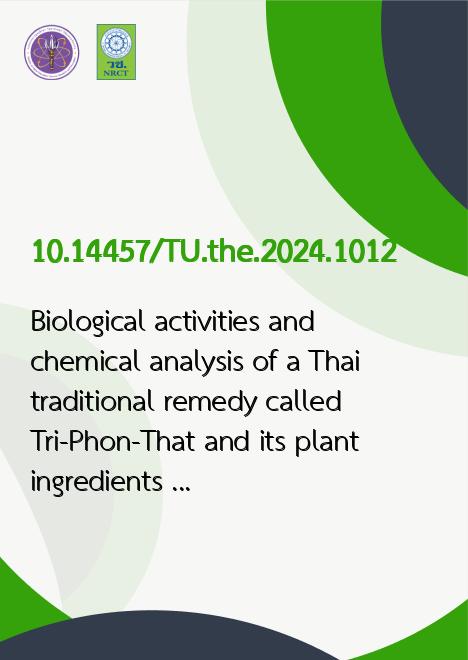| Abstract |
Herbal medicines are currently widely utilized to treat, alleviate, or rehabilitate various ailments. However, many herbs and remedies still lack sufficient research or validation. The Tri-Phon-That remedy, comprising the roots of three herbal plants: Zingiber zerumbet (ZZ), Zingiber montanum (ZM), and Cymbopogon nardus (CN), is one such formulation that has not been extensively studied. This remedy has documented properties for resolving fever, reducing swelling, and alleviating muscle pain. Previous research has indicated its efficacy in reducing pain in rats' hind paws and alleviating lower back pain in patients through oil application. Nevertheless, studies concerning the mechanisms of reducing pro-inflammatory mediators and antipyretic effects remain limited. Therefore, this study aimed to investigate the anti-inflammatory activity by examining the reduction of various mediators involved in inflammation, including nitric oxide, IL-6, PGE2, and TNF-α. Additionally, the study explored the antibacterial activity against potential fever-inducing bacteria, analyzed the chemical constituents of the remedy extract and its individual herbal components, and assessed the stability under accelerated conditions. Furthermore, due to the concern of cytotoxicity and skin irritation associated with CN, a comparative study was conducted between CN and Cymbopogon citratus (CC) as a substitute in remedy. The findings revealed that the extracts of the remedy and its individual herbal components obtained through maceration with 95% ethanol exhibited superior antibacterial and anti-inflammatory activities compared to those extracted via decoction.Regarding antibacterial activity, the ethanolic extracts demonstrated inhibitory effects against bacteria, while the aqueous extracts showed no such activity. The Tri-Phon-That remedy extract and its individual herbal components exhibited greater inhibitory effects against gram-positive bacteria (MIC = 39–2500 µg/mL) compared to gram-negative bacteria (MIC > 5000 µg/mL). Furthermore, the extracts effectively inhibited Streptococcus pyogenes, a significant causative agent of fever, with MIC values ranging from 39 to 312.5 µg/mL, and demonstrated good inhibitory activity against Streptococcus pneumoniae with MIC values ranging from 39 to 625 µg/mL. Regarding anti-inflammatory activity, the ethanolic extracts of the formulation containing C. nardus (TPECN) and the formulation containing C. citratus (TPECC) exhibited significant inhibitory effects on nitric oxide, IL-6, and PGE2 dose-dependently. The IC50 values of TPECN are 5.35 ± 0.77, 7.48 ± 0.26, and 24.75 ± 0.33 µg/mL, respectively. The IC50 values of TPECC are 7.02 ± 0.61, 10.46 ± 0.08, and 17.50 ± 0.03 µg/mL, respectively. Conversely, TNF-α inhibition was observed for both formulations, but exhibited IC50 values exceeding 100 µg/mL. Considering the cytotoxicity, it revealed that TPECN and TPECC showed cytotoxicity above 25 and 50 µg/mL, with safe concentrations at 30.81 ± 12.55 and 60.41 ± 11.40 µg/mL, respectively. Chemical analysis of the remedy extract and its herbal components revealed compound D, DMPBD, and zerumbone as key constituents, abundant in ethanolic extracts of the remedy. Zerumbone had the highest content, followed by DMPBD and compound D. They have 13.31 ± 0.87, 4.6 ± 0.30, and 3.16 ± 0.17 % w/w, respectively, for TPECN extract. The TPECC extract has 10.06 ± 0.31, 3.05 ± 0.08, and 2.38 ± 0.02 % w/w, respectively. Furthermore, the ZM ethanolic extract contained substantial amounts of compound D and DMPBD, quantified at 6.97 ± 0.28 % w/w and 8.58 ± 0.24 % w/w, respectively. Zerumbone was most concentrated in the ZZ ethanolic extract, measuring 36.05 ± 1.67 % w/w. Conversely, the chemical analysis of the CN and CC extracts in this study did not detect those chemical constituents investigated. Stability testing TPECN and TPECC under accelerated conditions for six months indicated a decline in anti-inflammatory activity, suppressing NO and IL-6 activity. This corresponded with a significant reduction in DMPBD and zerumbone levels, as well as a decrease in compound D levels. In conclusion, this study suggests that C. citratus may replace C. nardus in the Tri-Phon-That remedy. Further research is warranted to comprehensively evaluate the remedy's cytotoxicity and long-term storage stability to preserve bioactive components and sustained anti-inflammatory efficacy. Additionally, future studies should assess the long-term safety, cytotoxicity, and stability of these formulations under various conditions and their potential therapeutic benefits in clinical applications. |
